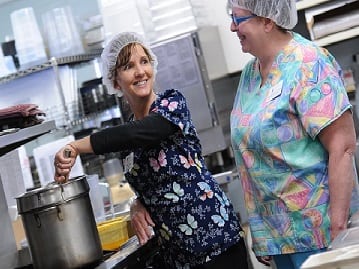When Julie Wolfe arrives at work at 5:45 a.m., it’s more than likely she’ll start preparing scrambled eggs and bacon. As a cook for Mennonite Memorial Home, Wolfe knows what her “customers” like and basic foods are always a hit. When she varies the breakfast menu, it’s usually with standard fare such as pancakes and biscuits and gravy.
“Our elders love bacon and eggs,” Julie laughed. “They also love anything that’s homemade and will ask if a dish was made from scratch.”
Although there are some frozen and prepared foods in supply in the MMH kitchen, mostly homemade dishes are served, especially soups and desserts.
According to Lori Neff, director of food service, menus for the elderly have become “liberalized” over the past few years. While those living in long-term care were once restricted in their food choices, the opposite is now true. Neff said residents can choose just about anything they want from the menu. While the dietary department follows guidelines in its diet manual and adheres to physician’s orders to assure a healthy selection, elders eat what they like. There are very few restricted diets and, when necessary, they’re done on an individual basis.
“If a 90-year-old gentleman has always had gravy on his mashed potatoes, who are we to tell him he can no longer have it,” said Neff. “It’s one more decision that is given back to our elders.”
Dining is a Social Experience
Cherrie Koontz, dietary aide, agrees. “We can point out good choices, but in the end, it’s up to the elder to decide.” Koontz, who has spent 28 years on the MMH food service staff, takes breakfast carts to the floors and serves those who eat in the assisted living dining room. Some residents in assisted living prefer to make their own morning meal and enjoy it in their apartments.
The three staff members agree, though, that the social aspect of elders dining together is important.
“We have a table of women who always talk and watch out for each other,” added Koontz. “The men usually spend more time eating than talking,” she laughed.
While many of us tend to gain weight as we age, for the MMH elders, it’s not a matter of overeating, but not eating enough of the right foods.
While the residents may prefer basic foods, the emphasis now is all about choices. An alternative menu is even available for those who just don’t like what’s being served. Neff monitors when items aren’t eaten, and if it happens a lot, that item is removed from the menu.
Times Have Changed for Food Service
Koontz reminisces how it “used to be” in the kitchen.
“I spent 10 years as night cook and we made just one meal. The residents didn’t really have a choice,” she recalled. “Now they have many more choices when it comes to food. Specialized diets are more individualized.”
Neff agrees, but stated that food service in long-term care is more regulated than it used to be. For example, the Ohio Department of Health mandates what size portions must be served, but it’s up to the elder to follow the mandate.
Wolfe said that basic food for lunch and dinner is defined as “meat, potatoes and a vegetable.” Residents seem to prefer their big meal at noon, which she attributes to having a farming background. “Old habits are hard to break,” she said.
A Certified Dietary Manager, Neff said that smaller organizations like Mennonite Home Communities of Ohio have the freedom to develop their own menus, while corporate-owned facilities usually have a standardized menu across the entire company.
“We can serve what our elders like and change the menu as needed,” she said.
Wolfe summed it up when she added, “We just like making people happy with food.”
As for the all-time favorite entrees, they include fried chicken, meat loaf and ham loaf. When it comes to desserts, pies “take the cake.”
“Everybody loves pies,” Wolfe laughed.

